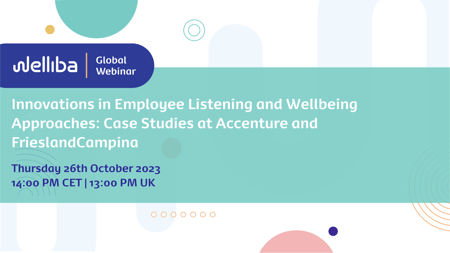Four Ways to Apply Recent Advancements in Measuring and Managing Employee Experience to Engagement Programmes
Employee engagement refers to the level of commitment that employees have towards their jobs and organisations. Although the vast majority of organisations use measurement tools to understand how their organisational performance is influenced by employee engagement, many researchers are sceptical about the return on investments of such survey tools. Research from 2002 by J. Harter1 suggests that employee engagement accounts for less than 10% of organisational performance variance, leaving most of this variance attributed to other factors. A study by Deloitte challenges traditional survey items, revealing that only three questions significantly contribute to performance differences: the chance to use one’s strengths, coworker commitment to quality work, and inspiration from the company culture (Buckingham & Goodall, 2015)2.
Most current approaches are limited by their perspective. The answers to engagement questions should be interpreted from a more holistic perspective. Most surveys in the market focus on the context of an organisation, but every company and every person is different. What drives engagement in one company may be very different from what works in a company with another context. Even within companies, hybrid working has made the idea of a single organisational context largely obsolete. If organisations do not understand people’s unique experiences in a given context, it is not surprising that they have a hard time linking engagement and employee experience to organisational performance.
No ‘one-size-fits-all’ approach to improving employee engagement
In order to maximise the benefits of employee engagement measurement, four challenges need to be addressed. Firstly, to explain actual performance differences in an organisation, much more granular information is needed as to ‘why’ an engagement score is high or low. Secondly, current engagement measurement approaches too often focus on providing organisational insights. When engagement surveys are sent to employees, employees only get to see the aggregate results of their team, department or the entire organisation. Most traditional engagement survey technologies fail to offer personalised insights to help individuals improve their own situation. Thirdly, people managers are often lost when they receive engagement data or reports. Poor-quality aggregate insights leave people managers with the question ‘Now what next?’. It is very time-consuming and costly for external consultants and/or HR teams to interpret aggregate engagement data and create plans with relevant actions. This leads to disappointing ROI on the engagement measurement initiatives. Fourthly, current engagement measurement approaches focus on what happened in the past rather than informing the actions of the future state of the team or organisation.
Welliba uses behavioural science and human-centred technology to overcome these four challenges by taking the concept of employee experience as a starting point.
1) We understand the root causes of high or low engagement
To understand differences in performance, Welliba can also capture someone’s motivation to start work, the chance to use one’s own strengths, coworker commitment to quality work, and inspiration from the company culture, or eNPS (the popular “How likely are you to recommend this company as a great place to work?”).
Contrary to the Net Promoter Score (NPS) which can be useful to measure customer and/or employee loyalty, the eNPS is of limited value because an employee-employer relationship is more complicated than a customer-supplier relationship and demands a multi-dimensional metric. Researchers uncovered new insights that were outside the limited perspective of ‘employee engagement’ or metrics like eNPS3. The state of mind of employees matters, but so does the context – the relationship with one’s colleagues and manager, available resources, communication practices, company culture, work conditions etc. This new concept was called: ‘Employee Experience’ (EX).
Welliba defines Employee Experience as how people experience their work and life, which is the result of the interaction between their characteristics and their environment. This holistic perspective is not just about a person’s mindset or what’s happening in an employee’s environment, but it is also about the actual interaction between a person and their context. By combining the most effective questions for measuring engagement that can explain differences in performance with the additional insights from the mindset and context data, organisations are able to pinpoint the actual underlying drivers that have an effect both on performance and on engagement. Welliba’s approach aims to account for each of the predictive drivers of engagement and EX; and rather than simply rating an employer, we can help match the needs of employers and employees by looking at their alignment from multiple perspectives.
2) We provide employees with insights to improve engagement
When employees share data with Welliba’s employee engagement & experience management system EX+, they immediately receive personalised insights to help them understand what influences their experience. As a result, they can find new ways to build on their strengths or develop in areas with room for growth. Welliba’s technology responsibly uses AI to provide personalised advice and can link employees to development resources that are available within their organisation, or to external resources. Letting employees engage with insights and resources to improve their own experience and engagement, turns Welliba’s approach into an important building block for people programmes that focus on employee experience and engagement. These programmes can help to improve business performance: research shows that organisations with more self-aware employees have stronger financial performance than organisations with employees that are less self-aware4.
3) We do not overlook manager insight and enablement
Managers can play a critical role in enabling individual and team performance. However, a research study covering more than 5,000 respondents uncovered that although 95% of leaders think they are self-aware, only 10-15% truly are (Eurich, 2018)5, making it difficult for them to use their strengths and/or work around growth areas. Welliba’s technology uses a validated EX model and dimensions to offer managers self-insight and to recommend actions that can tackle the root causes of what is holding back engagement. Such advice consists of personalised recommendations and guidance to internal and learning resources relevant to people leaders.
4) Our engagement measures are forward-looking and predict business outcomes
Most traditional engagement surveys help to analyse the current state at the point in time the survey data is captured. Analysing past engagement levels cannot effectively help drive actions to proactively change the future. Two large global samples with respondents from different roles, organisations, countries and demographic groups were used to analyse the strength of the link between Welliba’s EX model and relevant business outcomes. Regression and correlation analyses helped to identify how the Welliba model relates to the key business metrics that organisations are struggling to predict. The research findings clearly demonstrate that Welliba’s EX model can make relevant predictions with a measurable business impact. Welliba has identified key business themes that are relevant for organisations across economic sectors and locations. These key business themes can be clustered into two areas: People Commitment (factors that make people feel and be committed to their company) and People Risk (factors that make people quit, become disengaged and have poor physical wellbeing).
For instance, let’s take a closer look at ‘flight risk’: the likelihood that an employee will leave/quit their job. Failing to recognise employees who may leave or quit can cause businesses to suffer, so early detection of flight risk is crucial. For each of the key themes, we identified the most predictive drivers that influence these outcomes. For flight risk, these are purpose, focus, connectedness (all linked to individual characteristics which current engagement metrics do not measure) and team dynamics & culture, direct manager, and top-down communication (senior leadership to employees) which are linked to one’s environment.
Through Welliba's measurement of these predictive drivers, organisations and managers can take action before flight risk becomes an actual problem. Individuals who have scored low in these areas are also supported through insights and relevant resources provided before these drivers cause people to leave the organisation.
By overcoming these four challenges to measuring and managing engagement, Welliba can help organisations to sustainably improve future engagement levels and to evaluate the ROI of their current people programmes. Welliba EX+ measures engagement as part of its holistic approach to Employee Experience.
1Harter, J., Schmidt, F. & Hayes, T. (2002). Business-Unit-Level Relationship Between Employee Satisfaction, Employee Engagement, and Business Outcomes: A Meta-Analysis. The Journal of Applied Psychology, 87.
2Buckingham, M. & Goodall, A. (2015). Reinventing Performance Management. Harvard Business Review.
3Kular, S., Gatenby, M., Rees, C., Soane, E. & Truss, K. (2008). Employee Engagement: A Literature Review. Kingston University: Working Paper 19.
4Korn Ferry Institute Study (2015) Shows Link Between Self-Awareness and Company Financial Performance
5HBR, Eurich, T. (2018) What Self-Awareness Really Is (and How to Cultivate It). It’s not just about introspection








-1.png?width=450&height=261&name=Blog%20Post%20Image%20Size%20Correct%20(13)-1.png)
